Liquid stocks are the only type of stocks I’ll trade. Really, I only have two basic requirements — volatility and liquidity.
This isn’t rocket science. There aren’t a thousand different patterns or catalysts. There aren’t a thousand different requirements for finding the right stocks to trade. There are only a few that will work for you.
But you have to learn to recognize the patterns, catalysts, characteristics — all the things you do need to know. It takes studying. I recommend a mentor. Like me. Apply to join my Trading Challenge, and you’ll be part of a killer community.
OK, rant over.
Volatility is big price action — swings, movement. As a penny stock trader, volatility is your friend. So is liquidity, which is what this post is about. Let’s get to what you should know.
Table of Contents
- 1 What Are Liquid Stocks?
- 2 Difference Between Illiquid and Liquid Stocks
- 3 What’s a Highly Liquid Stock?
- 4 How to Identify Liquid Stocks in 5 Steps
- 5 List of the 3 Most Liquid Stocks in 2020
- 6 Frequently Asked Questions About Liquid Stocks
- 7 The Bottom Line on Liquid Stocks
What Are Liquid Stocks?

2025 Millionaire Media, LLCAs a day trader, I specifically look for liquidity when I’m considering a play. What are liquid stocks? Liquid stocks have enough trading volume that you can enter or exit a trading position without too much trouble. There are buyers and sellers making plays.
For a day trader, there’s not much worse than holding a 10,000-share position and watching the whole trade implode because you can’t buy or sell. Illiquid stocks don’t have enough trading volume to be a good opportunity. Plain and simple.
Benefits of Trading Liquid Stocks
One of the most important things I teach my Trading Challenge students is risk management. Your risk management strategy shouldn’t be an afterthought. That’s a fast way to disaster. Believe it or not, risk management is probably the #1 benefit of trading liquid stocks.
Day trading involves timing your plays with fast-moving prices. Penny stocks — the ones I trade — are volatile. Liquid stocks let me open and close positions quickly and stay within my risk management strategy.
Here’s a blunt fact about trading penny stocks: Most penny stocks are not liquid.
It’s one of the built-in cons — as in pros and cons — of trading penny stocks. That’s why I want you to understand how to find liquid stocks before you risk your hard-earned money.
If you already trade penny stocks, you know it might take a little longer to execute an order. It’s not like trading Microsoft (NASDAQ: MSFT), where your buy or sell order will get executed almost instantly. It’s a built-in feature of trading penny stocks that orders take a little longer to execute.
“But Tim, why would I want to trade stocks that take longer to execute? Isn’t that risky?”
That’s why I teach risk/reward ratio and risk management. In my opinion, hoping your shares in some giant corporation will make you rich before you retire is a real financial risk!
Here’s the deal …
I recommend you look into penny stocks that trade in the range of 200,000 to five million shares per day. They’re liquid, but not the most active. Penny stocks that trade in the 50 million-plus range are liquid but too choppy for me. I tend to get scared out of the trade.
Also, understand the market can shift. Last month’s supernova might have already fizzled out. What’s in play this week might not be in play next week. Trading strategies change based on what’s really going on in the market.
There’s a lot less competition trading penny stocks. Plus, as long as you know beforehand that you need to find stocks with good liquidity, you’re already one up on the competition. Seriously.
Most people buy these stocks because promoters hype them to their email lists. Maybe the company thinks it has the next big thing, so it puts out a press release. Let me tell you a secret: almost all these companies will fail. Don’t think you’re getting in on the next MSFT at the beginning. You’re not.
You’re here to learn how to trade, and you want the best chance of finding consistency.
Here’s a big-picture reason to be a fan of liquidity: Imagine what would happen if there wasn’t a liquid stock market. If it was difficult to buy and sell shares, the markets would grind to a halt. It would affect investment in businesses. Who wants to invest in a company only to be told you can’t get out of the investment?
The secondary market for company shares and other types of securities is what makes investing in a company attractive. The secondary market is what you and I are trading. A liquid stock market is what makes it possible.
Back to liquidity in penny stocks…
Why Liquidity Is Important When Determining Entry/Exit Indicators
Knowing your entry and exit points will help you determine whether a trade fits your risk management strategy. Ultimately, it determines the success or failure of your trade.
No matter how well you plan, not every trade will work out in your favor. I only win about 77% of the time.* If you do your homework and create a plan for your trade, you’ll have targets for when to open and close your position.
(*Please note that these kinds of trading results are not typical. Most traders lose money. It takes years of dedication, hard work, and discipline to learn how to trade, and individual results will vary. Trading is inherently risky. Before making any trades, remember to do your due diligence and never risk more than you can afford to lose.)
Plan? What plan? If you follow what I teach, you’ll have every detail of the trade ready to execute beforehand. And not just the entry and exit points. You’ll know what pattern you’re trading, the reason or catalyst, how much you’re willing to lose should the trade turn against you (risk/reward)…
Make sense?
This isn’t gambling. It’s a skill. Remember that. Get my “Trader Checklist Part Deux” DVD so you know what goes into your plan. I go over all the indicators in my Sykes Sliding Scale that can help you determine the best trades to take.
Now here’s…
Why You Should Only Trade Liquid Stocks
OK, say you’re ready to make your play. But what if you missed the mark on liquidity? What if trading volume sucks or there’s some sort of slowdown for whatever reason? You could have everything worked out and then not be able to get in or out of your trade and end up completely screwed.
In your plan, it’s called ease of entry and exit. Entries and exits rely on timing. Liquidity has an effect on timing. Remember, orders take time to execute. You want to be in and out of your positions as close as possible to your targets.
When building my watchlist, I have a few requirements:
- I’m looking for penny stocks that are highly volatile…
- And highly liquid…
- Then I’m looking for big price moves and a catalyst that makes sense, like news or an earnings release.
For liquidity, you want to keep an eye on trading volume. Don’t mess around with illiquid stocks — they’ll come back and bite you.
What’s my #1 rule? If you’ve been following me for a while you should know this. If not, make it a mantra: Cut losses quickly. Liquidity makes this possible. Of course, you still have to act on it…
Chasing trades is a bad idea…
…. but if the stock is highly liquid at least you can close your position, win or lose.
Difference Between Illiquid and Liquid Stocks
A liquid stock is tradeable. An illiquid stock isn’t. I won’t trade illiquid stocks, and I warn new traders not to either. You can get trapped in your position and can’t get out without pushing the price of the stock down.
It’s how I lost $500,000 of my own money. I invested in a penny stock and believed in its technology. But it crashed, and I was stuck holding shares. I couldn’t sell without pushing the stock price down even further. It ends up being you vs. you — you’re the only one trading the stock!
Read about it all in my book, “An American Hedge Fund.” (There’s no cost to get your copy.)
A similar thing happened to my student Michael Goode. He was shorting a stock. It became illiquid, and he was forced to buy to cover. He created his own short squeeze. Check it out in this video.
A lot of investors associate small-cap stocks with illiquidity. Sure, they trade less volume than large-cap stocks, but that’s just one of many considerations…
What’s the stock float or the volume relative to the float? What position size do you want to take? For small retail traders, like my students and me, there’s usually plenty of liquidity in a stock running on news.
But if you want to buy hundreds of thousands of shares of a stock on an average day, your buy orders will likely impact the stock price.
What’s a Highly Liquid Stock?
A highly liquid stock is a stock that’s heavily traded with lots of volume. Think stocks like Apple Inc. (NASDAQ: AAPL) and Tesla Inc. (NASDAQ: TSLA). They’re heavily traded — you can get in and out of your positions easily because there are always buyers and sellers.
Penny stocks can also become highly liquid. When news or another catalyst brings traders and investors into a stock, it can lead to huge volume. Especially relative to the float size.
Be careful trading low float stocks. When high volume comes in, it can cause volatile price swings — to the upside and the downside.
How to Identify Liquid Stocks in 5 Steps

2025 Millionaire Media, LLCBy now you should have the importance of liquidity burned into your brain. So how do you find stocks with good liquidity?
More Breaking News
- Tesla Stock Moves: What’s Driving It?
- MediaCo’s Latest Moves: Is An Upswing On The Horizon?
- Sonnet BioTherapeutics: Analyzing the Recent Surge
#1: Use a Stock Screener
The right tools make all the difference. Can you imagine trying to do something, almost anything, without tools? How about something simple, like raking leaves without a rake? Not possible.
You need the right tools. It’s an investment in your future. A high-quality stock screener can help you find the stocks you’re looking for.
If you’re new to trading, start with one of the free tools…
Head over to finviz.com and click the screener tab. There, you can screen for stocks listed on one of the major exchanges. However, there are limitations, and certain stocks won’t show up even if you know the ticker symbol.
To trade penny stocks you’ll need to have a bunch of different stock screeners open on your multi-monitor trading setup. Or you could use the one tool to rule them all…
StocksToTrade
Now we’re talkin’.
To me, StocksToTrade is like the Lamborghini of stock trading software. It’s a super-advanced, real-time scanning and trading platform that I helped design (I’m also a major investor). It’s made for what I do and what I teach all my Trading Challenge students to do.
Did I mention it’s real time? If you go over to finviz and look for liquid stocks based on what I’ve written in this post, it’s a good thing for your education. But when it comes time to trade, you need to have access to information in real-time. Top-quality tools like StocksToTrade can help make your life SO much easier.
Yes, it costs. Like any business, penny stock trading requires an investment. I think it’s well worth it. The Breaking News Chat is responsible for a huge portion of my trading profits in 2020.* It helps me see the news fast so I can react.
Back to liquidity and volume using StocksToTrade. It used to be clunky to get average volume on other stock screeners…
But now StocksToTrade does this in its most basic widget, the Basics Box. It includes the high, low, and opening price. It includes volume and average volume. It includes the float, market capitalization, earnings per share…
That’s without even getting into the screener. Spend any extra free time you have after using the right tools with your family. Or read a book like “The Complete Penny Stock Course” (It was written by my student Jamil.) Let the software do the work it’s designed to do.
#2: Use Chart Patterns While Trading Liquid Stocks
I love to trade patterns. It’s all I do. It’s how I made my first million, my second million* — pretty much all my trading wins are from recognizable patterns. There are a few you should learn.
Example of Great Chart Patterns
Here are a couple of my favorite plays. They tend to happen over and over again. There are haters out there who say things like, “Tim talks about patterns that don’t work anymore. They’re all played out …” The way I look at it, these patterns stand the test of time. Why? Because they’re based on human psychology. That tends to be predictable.
Morning Panics
Dip buying morning panics is one of my recent favorites. CytoDyn Inc. CYDY (OTCQB: CYDY) is a great example of a panic and bounce. I traded this stock for a profit, and so did a lot of my students.* They even traded it better than me. (see all my trades here.)
The psychology of this play is what you want to recognize. Why morning? Because the trading volume is higher — the stock is more liquid and more likely to bounce.
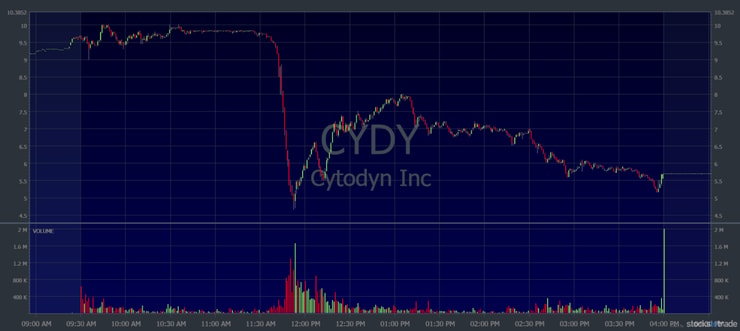
Supernova
This is one of my all-time favorite patterns. It made me my first million.* Check out the CYDY daily chart. This was one of the top OTC stocks of 2020. It offered a bunch of trading opportunities.
Notice the volume spike as it went supernova — liquidity increased during the price spike and inevitable fall on June 30.
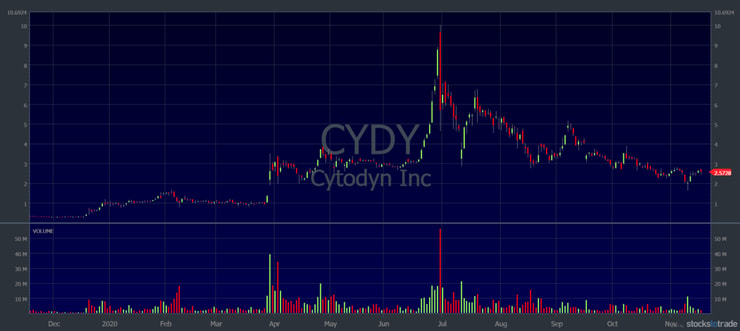
#3 Stock Analysis
Part of what you’ll learn when you join the Trading Challenge is how to do stock analysis. But not a super-math-whiz type of analysis. I don’t use the fancy technical analysis indicators. Day highs, lows, and momentum work for most of the trades I make.
That’s not to say you won’t have to study your butt off! You will. There’s no cheating success in the stock market.
Technical and Fundamental Analysis
You need to learn both technical and fundamental analysis. Most losses come from disregarding some key indicator. It might be something from either of these two methods.
Fundamental analysis is more about the company — how does it do business? What are its products? Is it doing deals with some big, established company? Will the company release a new product soon?
Technical analysis is like the charts above. How is the stock behaving? Is there enough trading volume? Are there trading patterns forming? Do you see a history of morning panics?
A combination of technical and fundamental analysis should be part of your trading plan. Keep it in a trading journal so you can remember what works and what blows.
#4 Be Prepared to Short the Stock
Short selling means you borrow shares to sell. When you sell the borrowed shares, the money goes into your trading account. Then, when the price drops, you buy shares at the lower price and pay back the borrowed shares.
This strategy is not always available — and it can be downright dangerous. That’s why I don’t recommend it for newer traders. You can lose far more money than you have in the trade, and short squeezes can happen super fast!
Don’t forget to subscribe to my YouTube channel — there are over 1,500 videos there to help you learn lessons just like this one.
#5 Never Stop Learning
I don’t care how good you are, how long you’ve been trading, or how much money you’ve made …
… if you want to do this full-time and live a life most people can’t…
… then you need to do what most people won’t do…
Never stop learning. Keep your trading education going. Study like your entire future depends on it.
What’s the best way to do that? Apply for my…
Trading Challenge
My Trading Challenge gives you access to tons of information: webinars, video lessons, a community with other Trading Challenge students — plus advice from successful traders.
The Trading Challenge is my blueprint for creating self-sufficient stock market traders.
It’s everything I’ve learned from 20+ years of trading and 10+ years of teaching others how to trade. All of my most successful students are part of the Trading Challenge.*
I’ll teach you from A to Z. It doesn’t matter if you know nothing about the stock market or you’re not good at math (I’m not either). You don’t have to be a genius. But you will have to work hard.
Are you ready? Apply for the Trading Challenge today.
List of the 3 Most Liquid Stocks in 2020

2025 Millionaire Media, LLCLiquidity is … well, liquid. It changes from day to day based on the traders and investors trading the stock. Sure there’s a lot of stocks that trade high volume every day — mostly large-cap stocks.
But in penny stock land you have to follow the liquidity. That’s why I don’t hold these stocks too long. When the volume and liquidity are gone, you could be stuck holding a bag — of trash.
Let’s look at some of the stocks that had huge liquidity at some point during the year…
Sorrento Therapeutics Inc. (NASDAQ: SRNE)
SRNE had a huge run on news on May 15. The stock traded over 500 million shares on the day. Throughout 2020, it had multiple days trading over 100 million shares.
Even the days of lower volume were still just under 10 million a day.
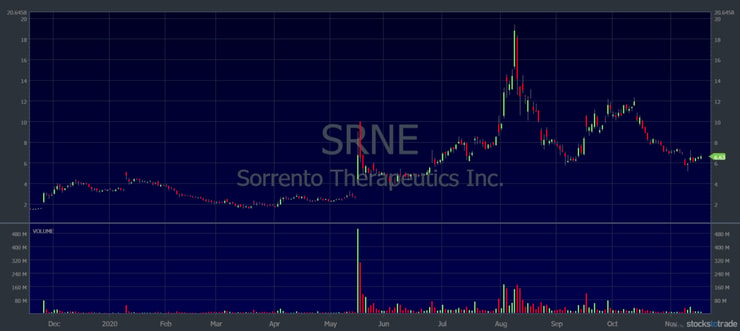
NIO Limited (NYSE: NIO)
NIO has been a huge gainer this year. Back in May, the stock was trading around $3 per share. As of this writing, it’s trading in the $40s.
The stock’s had plenty of days with over 200 million in volume. A slow day for NIO is trading volume of only around 50 million shares.
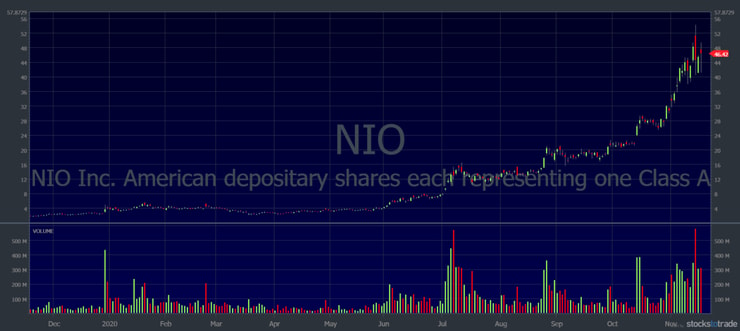
iBio Inc. (NYSE: IBIO)
IBIO is a biotech company that’s benefited from the coronavirus pandemic. The stock was trading below 50 cents at the beginning of the year. Then in February, it saw a huge volume and price increase.
On February 27, it traded 197 million shares. The following day it traded 263 million shares. The stock price went from below 50 cents to over $3 per share in those two days.
In July, the stock saw huge volume and price increases again, trading 270 million shares in one day. You can see from the chart the volume declined significantly to an average of around three to five million shares.
That’s still plenty of volume — but maybe not for the big Wall Street players.
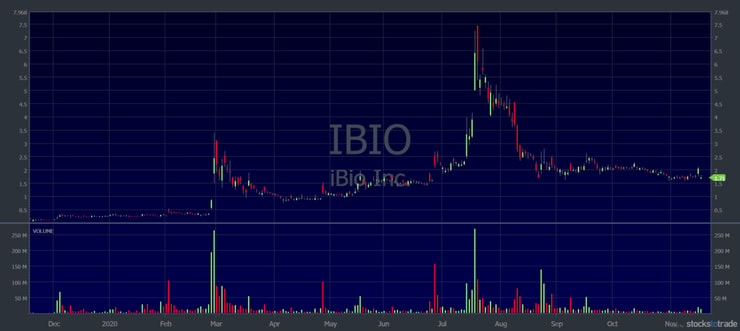
Frequently Asked Questions About Liquid Stocks
What’s Liquid in Trading?
Liquidity in stocks is volume. It’s a word used to describe how easily you can get in and out of a position. If the stock doesn’t have enough volume, your buy or sell can affect the stock price.
Which Stock Is Most Profitable?
A stock in itself is not profitable. It’s how you trade it that makes it a profit or a loss. You should have a trading plan, rules, and discipline. That’s what I teach my students, and everything else I know, in my Trading Challenge.
What Are Illiquid Stocks?
Illiquid stocks are stocks with no volume or interest. Nobody’s trading them because they’re usually boring, worthless stocks. If a stock is illiquid and you buy it, your purchase will likely increase the stock price. And if you’re stuck in an illiquid stock, your sell order can push the stock price down.
The Bottom Line on Liquid Stocks
Remember this…
I tell my students they should have a trading mantra. So let’s come up with one right now. Repeat after me: “I will trade volatile and liquid stocks.” Repeat it to yourself every day.
Stock liquidity for traders means ease of entry and exit. It means you won’t be stuck in a trade. There are other things to consider as well. Don’t think because a stock is liquid and volatile, it’s a gimme. But liquidity is one of the basic things you should look for.
What do you look for when it comes to liquid stocks? Share your comment below, I want to hear from you.



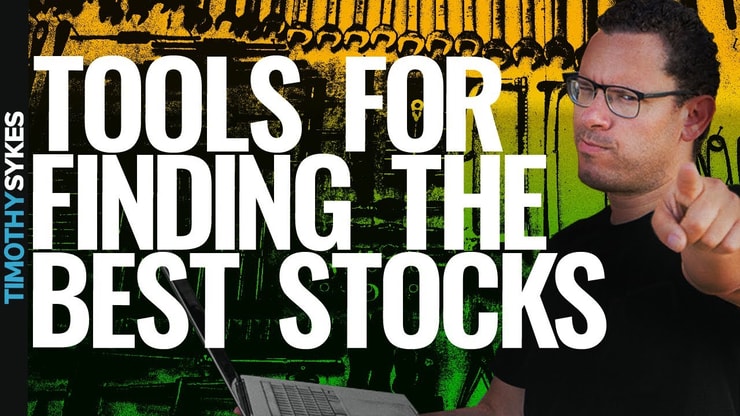









Leave a reply